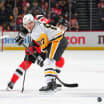Mears Gets Once-In-A-Lifetime Experience at US Open
The Penguins broadcaster recently called matches at the tennis championships

Mears, the Penguins play-by-play broadcaster on AT&T SportsNet, called twelve matches at the 2020 US Open Tennis Championships on TV from Aug. 31 to Sep. 7.
The US Open, which is the fourth and final Grand Slam tournament of the year, runs through Sep. 13 and is being played without fans at the USTA Billie Jean King National Tennis Center in New York City.
"I'm sitting in a stadium watching Serena Williams, Novak Djokovic, Naomi Osaka or any of those other great players, and I'm thinking, this is like watching Mario Lemieux in a playoff game with nobody here," Mears said. "Other than some camera people and maybe a coach or two. So I definitely tried to soak it all up."
Mears was approached about calling some matches at the prestigious tournament a few months back, and thought it was a tremendous opportunity to try something different.
"I don't think you'd get anything more polar opposite than hockey and tennis as far as doing play-by-play, so it just sharpens your broadcasting skills," Mears said.
And then as a kid who grew up in the 90s watching tennis legends like Andre Agassi, Pete Sampras and Steffi Graff, it was an opportunity he couldn't pass up from a fan perspective. It turned out to be one of the coolest experiences of Mears' career, and also one of the most bizarre.
"Normally that Tennis Center is just buzzing with energy," Mears said. "You have hundreds of thousands of people that attend the event every year, and every court is jam-packed, but this year, it was a bubble situation very similar to the NHL. And in this case, because we were in the bubble, we were able to go around when I wasn't working calling matches."
In fact, broadcasters were actually encouraged to go around and watch matches because the players wanted to have as much of an atmosphere as they could get within the circumstances. So Mears made the most of it.
"Every moment of downtime, I was at a court just watching," he said. "Because I'm thinking, when is this going to be happening again? I'm just sitting there and enjoying watching some of the best players in the world who are right in front of me. It was such a surreal feeling. That was one of the coolest parts."
Obviously Mears knew they are all incredible athletes, but it still blew him away watching them up close after watching so much hockey over the years.
"For anybody who hasn't seen tennis up close, I'm amazed by the agility, the lower-body strength, the hand-eye coordination, the upper-body strength," Mears said. "I think tennis players would make good hockey players and vice versa, because there are a lot of same skills."
When he wasn't watching, Mears was working. He was grateful for the amount of time he had to prepare, considering he initially had a fan's knowledge versus a broadcaster's or an expert's knowledge.
Leading up to the tournament, Mears watched a lot of tennis exhibition games and did his homework on all of the athletes. His hockey background helped with learning the pronunciations of their names, as tennis is also an international sport.
Once Mears got to the bubble - where there were daily temperature checks/questionnaires and COVID-19 tests every four days - the first match he called was between Ali Riske, who is from Pittsburgh, and Ann Li, who is from eastern Pennsylvania.
From there, Mears called matches that featured Daniil Medvedev and Jen Brady, who advanced to their respective semifinals, and Tsvetana Pironkova and Andrey Rublev, who lost in their respective quarterfinals.
It was helpful only having to prepare for two athletes - or four in the case of a doubles match - versus 40 athletes in a hockey game. However, the pace of a tennis match is much different, so Mears relied a lot on his color analysts - usually a different one each time - who were mostly all former tennis players.
"There's a lot of downtime," Mears said. "I tried to use my partner as best as I could, trying to tap into his or her expertise, because they played the game and I didn't."
It was certainly a crash course in tennis broadcasting, but one Mears was more than happy to take.
"It was like broadcasting bootcamp. You just go in, you're doing multiple matches a day, you're doing some matches of athletes you've never heard of before and it's up to you to do all the homework. And I think it went really well. I just had fun with it. It was something really cool."


















































